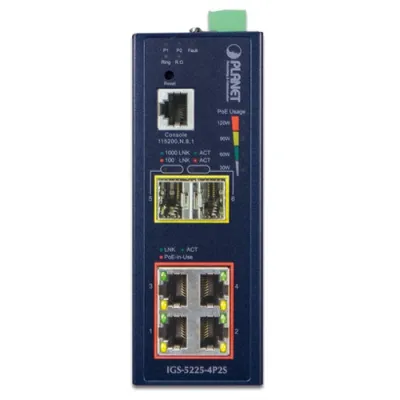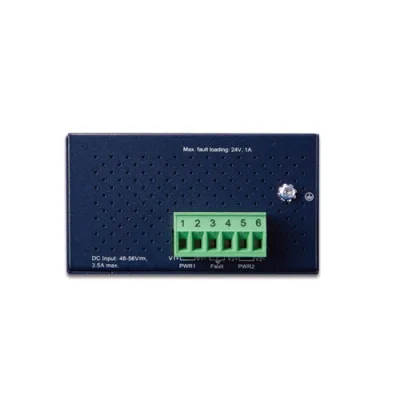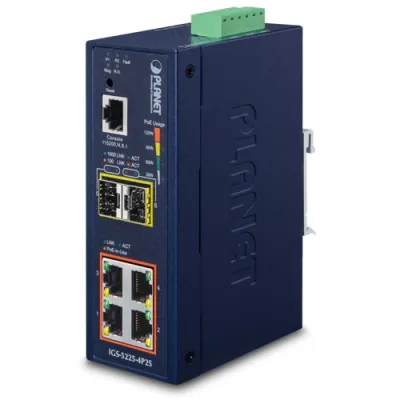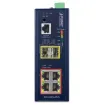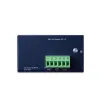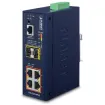Planet - IGS-5225-4P2S - IP40 Industrial L2+/L4 4-Port 1000T 802.3at PoE + 2-Port 100/1000X SFP Full Managed Switch (-40 to 75 C)
Advanced Manageable PoE Solution for Hardened Environment
PLANET’s IGS-5225-4P2S L2+ Industrial Managed PoE+ Switch, features 4 10/100/1000BASE-T 802.3at PoE+ ports (36 watts per port), and 2 100/1000X fiber ports in an IP40 rugged but compact-sized case. It provides user-friendly advanced IPv6/IPv4 management interfaces, abundant L2/L4 switching functions, Layer 3 static routing capability, and advanced ITU-G.8032 ERPS Ring technology. It improves the rapid self-recovery capability and PLANET’s intelligent PoE functions for controlling the PoE outdoor IP surveillance and wireless network applications. It is able to operate reliably, stably and quietly in extended temperature ranges from -40 to 75°C.
PLANET Network Management System (NMS) Solution
The IGS-5225-4P2S supports PLANET’s NMS via CloudViewer App which is an Intelligent App to monitor your network from the cloud. With a cloud network, it makes data and services available from anywhere with an Internet connection. With PLANET CloudViewer, your network status can be monitored in real time anytime, anywhere via your mobile phone or tablet. User can easily check network status, device information, and port and PoE statuses from the cloud to reduce management costs.
Cybersecurity Network Solution to Minimize Security Risks
The cybersecurity feature that virtually needs no effort and cost to have includes the protection of the switch management and the enhanced security of the mission-critical network. Both SSH and SSL protocols are utilized to provide strong protection against advanced threats. The network administrator can now construct highly-secure corporate networks with considerably less time and effort than before.
Convenient and Smart ONVIF Devices with Detection Feature
PLANET’s ONVIF Support is specifically designed for co-operating with video IP surveillances. From the GUI of the IGS-5225-4P2S, you can search and view all of the ONVIF devices via network application with just one click. In addition, you can upload floor images to the switch and can remotely monitor or inspect an assembly line. You can get real-time surveillance information and online/offline status and the PoE reboot can be controlled from the GUI.
Built-in Unique PoE Functions for Powered Devices Management
As it is the managed PoE switch for surveillance, wireless and VoIP networks, the IGS-5225-4P2S features the following special PoE management functions:
- PD alive check
- PoE schedule
- Scheduled power recycling
- PoE usage monitoring
Intelligent Alive Check for Powered Device
The IGS-5225-4P2S PoE switch can be configured to monitor connected PDs status in real time via ping action. If the PD stops working and responding, the IGS-5225-4P2S will recycle the PoE port power and power back up the PD. It also greatly enhances the reliability in that the PoE port will reset the PD power, thus reducing administrator’s management burden.
PoE Schedule for Energy Saving
The eco-friendly IGS-5225-4P2S can effectively control the power supply besides its capability of giving high watts power. The built-in PoE schedule function helps you to enable or disable PoE power feeding for each PoE port during specified time intervals and it is a powerful function to help SMBs or enterprises save power and money.
Scheduled Power Recycling
The IGS-5225-4P2S allows each of the connected PoE IP cameras or PoE wireless access points to reboot at a specific time each week. Therefore, it will reduce the chance of an IP camera or AP crash resulting from buffer overflow.
SMTP/SNMP Trap Event Alert
The IGS-5225-4P2S provides event alert function to help to diagnose the abnormal device owing to whether or not there is a break of the network connection, or the rebooting response.
Effective Alarm Alert for Better Protection
The IGS-5225-4P2S supports a Fault Alarm feature which can alert the users when there is something wrong with the switches. With this ideal feature, the users would not have to waste time finding where the problem is. It will help to save time and human resource.
Layer 3 IPv4 and IPv6 Software VLAN Routing for Secure and Flexible Management
To help customers stay on top of their businesses, the IGS-5225-4P2S not only provides ultra high transmission performance and excellent Layer 2 technologies, but also IPv4/IPv6 software VLAN routing feature which allows to cross over different VLANs and different IP addresses for the purpose of having a highly-secure, flexible management and simpler networking application.
Robust Layer 2 Features
The IGS-5225-4P2S can be programmed for advanced switch management functions such as dynamic port link aggregation, Q-in-Q VLAN, private VLAN, Rapid Spanning Tree Protocol, Layer 2 to Layer 4 QoS, bandwidth control and IGMP snooping. The IGS-5225-4P2S provides 802.1Q tagged VLAN, and the VLAN groups allowed will be maximally up to 255. Via aggregation of supporting ports, the IGS-5225-4P2S allows the operation of a high-speed trunk combining multiple ports. It enables a maximum of up to 2 trunk groups with 2 ports per trunk group, and supports fail-over as well.
Efficient Management
For efficient management, the IGS-5225-4P2S is equipped with console, Web and SNMP management interfaces. With the built-in Web-based management interface, the IGS-5225-4P2S offers an easy-to-use, platform-independent management and configuration facility. For text-based management, the IGS-5225-4P2S can be accessed via Telnet and the console port. Moreover, it also offers secure remote management via any standard-based management software by supporting SNMPv3 connection which encrypts the packet content at each session.
Powerful Security
The IGS-5225-4P2S offers comprehensive Layer 2 to Layer 4 Access Control List (ACL) for enforcing security to the edge. It can be used to restrict network access by denying packets based on source and destination IP address, TCP/UDP ports or defined typical network applications. Its protection mechanism also comprises 802.1x Port-based and MAC-based user and device authentication. With the private VLAN function, communication between edge ports can be prevented to ensure user privacy. The network administrators can now construct highly-secure corporate networks with considerably less time and effort than before.
Modbus TCP Provides Flexible Network Connectivity for Factory Automation
With the supported Modbus TCP/IP protocol, the IGS-5225-4P2S can easily integrate with SCADA systems, HMI systems and other data acquisition systems in factory floors. It enables administrators to remotely monitor the industrial Ethernet switchs operating information, port information and communication status, thus easily achieving enhanced monitoring and maintenance of the entire factory.
1588 Time Protocol for Industrial Computing Networks
The IGS-5225-4P2S is ideal for telecom and Carrier Ethernet applications, supporting MEF service delivery and timing over packet solutions for IEEE 1588 and synchronous Ethernet.
Flexibility and Extension Solution
The additional four mini-GBIC slots built in the IGS-5225-4P2S support dual speed, 100BASE-FX and 1000BASE-SX/LX SFP (Small Form-factor Pluggable) fiber-optic modules, meaning the administrator now can flexibly choose the suitable SFP transceiver according to not only the transmission distance but also the transmission speed required. The distance can be extended from 550 meters (multi-mode fiber) to 10/50/70/120 kilometers (single-mode fiber or WDM fiber). They are well suited for applications within the enterprise data centers and distributions.
Intelligent SFP Diagnosis Mechanism
The IGS-5225-4P2S supports SFP-DDM (Digital Diagnostic Monitor) function that greatly helps network administrator to easily monitor real-time parameters of the SFP, such as optical output power, optical input power, temperature, laser bias current, and transceiver supply voltage.
Features:
- Ports: 4 10/100/1000TX + 2 100/1000X SFP
- Type of Switch: Managed
- PoE Ports: 4
- Standards: 802.3at PoE Plus PSE
- Total PoE Budget: 144W
- Switch Fabric: 12Gbps / non-blocking
- Max. Power Consumption: 6.3W / 21.6BTU (power on w/0 any connection), 151.8W/520.8BTU (full loading w/PoE)
- Throughput: 8.9Mpps 64Bytes
- Operating Temperature: -40 to 75°C
- Supports: IEEE 1588v2 Transparency, ERPS Ring, DIDO, Cloudviewer App (more info. below)
- TAA Compliant
| Hardware Specifications | |
|---|---|
| Copper Ports | 4 10/100/1000BASE-T RJ45 auto-MDI/MDI-X ports |
| SFP/mini-GBIC Slots | 2 1000BASE-SX/LX/BX SFP interfaces (Port-5 to Port-6) Compatible with 100BASE-FX SFP |
| PoE Injector Port | 4 ports with 802.3at/af PoE injector function with Port-1 to Port-8 |
| Console | 1 x RJ45-to-RS232 serial port (115200, 8, N, 1) |
| Switch Architecture | Store-and-Forward |
| Switch Fabric | 12Gbps/non-blocking |
| Throughput (packet per second) | 8.928Mpps@ 64 bytes packet |
| Address Table | 8K entries, automatic source address learning and aging |
| Shared Data Buffer | 4Mbits |
| Flow Control | IEEE 802.3x pause frame for full duplex Back pressure for half duplex |
| Jumbo Frame | 9Kbytes |
| Reset Button | <5 sec: System reboot >5 sec: Factory default |
| ESD Protection | 6KV DC |
| Enclosure | IP40 metal case |
| Installation | DIN-rail kit and wall-mount kit |
| Connector | Removable 6-pin terminal block for power input Pin 1/2 for Power 1, Pin 3/4 for fault alarm, Pin 5/6 for Power 2 |
| Alarm | One relay output for power failure. Alarm relay current carry ability: 1A @ 24V DC |
| LED Indicator | System: Power 1 (Green) Power 2 (Green) Fault Alarm (Red) Ring (Green) Ring Owner (Green) Per 10/100/1000T RJ45 PoE+ Ports: PoE-in-Use (Orange) LNK/ACT (Green) Per SFP Interface: 100 LNK/ACT (Orange) 1000 LNK/ACT (Green) |
| Dimensions (W x D x H) | 50 x 87.8 x 135 |
| Weight | 610g |
| Power Requirements | Dual 48~56V DC (>51V DC for PoE+ output recommended) |
| Power Consumption | Max. 6.2 watts/26.76BTU (Power on without any connection) Max. 151.8 watts/520.82BTU (Full loading with PoE function) |
| Power Over Ethernet | |
| PoE Standard | IEEE 802.3at Power over Ethernet Plus/PSE |
| PoE Power Supply Type | End-span |
| PoE Power Output | IEEE 802.3af Standard – Per port 48V~51V DC (depending on the power supply), max. 15.4 watts IEEE 802.3at Standard – Per port 51V~56V DC (depending on the power supply), max. 36 watts |
| Power Pin Assignment | 1/2(+), 3/6(-) |
| PoE Power Budget | Dual power input: 144W maximum (depending on power input) |
| Max. Number of Class 2 PDs | 4 |
| Max. Number of Class 3 PDs | 4 |
| Max. Number of Class 4 PDs | 4 |
| Layer 2 Function | |
| Basic Management Interfaces | Console; Telnet; Web browser; SNMP v1, v2c |
| Secure Management Interfaces | SSH, SSL, SNMP v3 |
| Port Configuration | Port disable/enable Auto-negotiation 10/100/1000Mbps full and half duplex mode selection Flow control disable/enable Power saving mode control |
| Port Status | Display each ports speed duplex mode, link status, flow control status, auto negotiation status, trunk status |
| Port Mirroring | TX/RX/both 1 to 1 monitor |
| VLAN | IEEE 802.1Q tag-based VLAN, up to 255 VLAN groups IEEE 802.1ad Q-in-Q tunneling Private VLAN Edge (PVE) MAC-based VLAN Protocol-based VLAN Voice VLAN MVR (Multicast VLAN Registration) GVRP Up to 255 VLAN groups, out of 4094 VLAN IDs |
| Link Aggregation | IEEE 802.3ad LACP/static trunk Supports 2 trunk groups with 2 ports per trunk group |
| QoS | Traffic classification based, strict priority and WRR 8-level priority for switching – Port number – 802.1p priority – 802.1Q VLAN tag – DSCP/TOS field in IP packet |
| IGMP Snooping | IPv4 IGMP (v1/v2/v3) snooping, up to 255 multicast groups IPv4 IGMP querier mode support |
| MLD Snooping | IPv6 MLD (v1/v2) snooping, up to 255 multicast groups IPv6 MLD querier mode support |
| Access Control List | IP-based ACL/MAC-based ACL Up to 123 entries |
| Bandwidth Control | Per port bandwidth control Ingress: 500Kb~1000Mbps Egress: 500Kb~1000Mbps |
| SNMP MIBs | RFC 1213 MIB-II IF-MIB RFC 1493 Bridge MIB RFC 1643 Ethernet MIB RFC 2863 Interface MIB RFC 2665 Ether-Like MIB RFC 2819 RMON MIB (Groups 1, 2, 3 and 9) RFC 2737 Entity MIB RFC 2618 RADIUS Client MIB RFC 2933 IGMP-STD-MIB RFC 3411 SNMP-Frameworks-MIB IEEE 802.1X PAE LLDP MAU-MIB |
| Layer 3 Function | |
| IP Interfaces | Max. 8 VLAN interfaces |
| Routing Table | Max. 32 routing entries |
| Routing Protocols | IPv4 software static routing IPv6 software static routing |
| Standards Conformance | |
| Regulatory Compliance | FCC Part 15 Class A, CE |
| Stability Testing | IEC60068-2-32 (free fall) IEC60068-2-27 (shock) IEC60068-2-6 (vibration) |
| Standards Compliance | IEEE 802.3 10BASE-T IEEE 802.3u 100BASE-TX/100BASE-FX IEEE 802.3z Gigabit SX/LX IEEE 802.3ab Gigabit 1000T IEEE 802.3x flow control and back pressure IEEE 802.3ad port trunk with LACP IEEE 802.1D Spanning Tree Protocol IEEE 802.1w Rapid Spanning Tree Protocol IEEE 802.1s Multiple Spanning Tree Protocol IEEE 802.1p Class of Service IEEE 802.1Q VLAN tagging IEEE 802.1ad Q-in-Q VLAN stacking IEEE 802.1X Port Authentication Network Control IEEE 802.1ab LLDP IEEE 802.3af Power over Ethernet IEEE 802.3at Power over Ethernet Plus IEEE 1588 PTPv2 RFC 768 UDP RFC 793 TFTP RFC 791 IP RFC 792 ICMP RFC 2068 HTTP RFC 1112 IGMP v1 RFC 2236 IGMP v2 ITU G.8032 ERPS Ring |
| Environment | |
| Operating Temperature | -40 ~ 75 degrees C |
| Storage Temperature | -40 ~ 85 degrees C |
| Humidity | 5 ~ 95% (non-condensing) |

